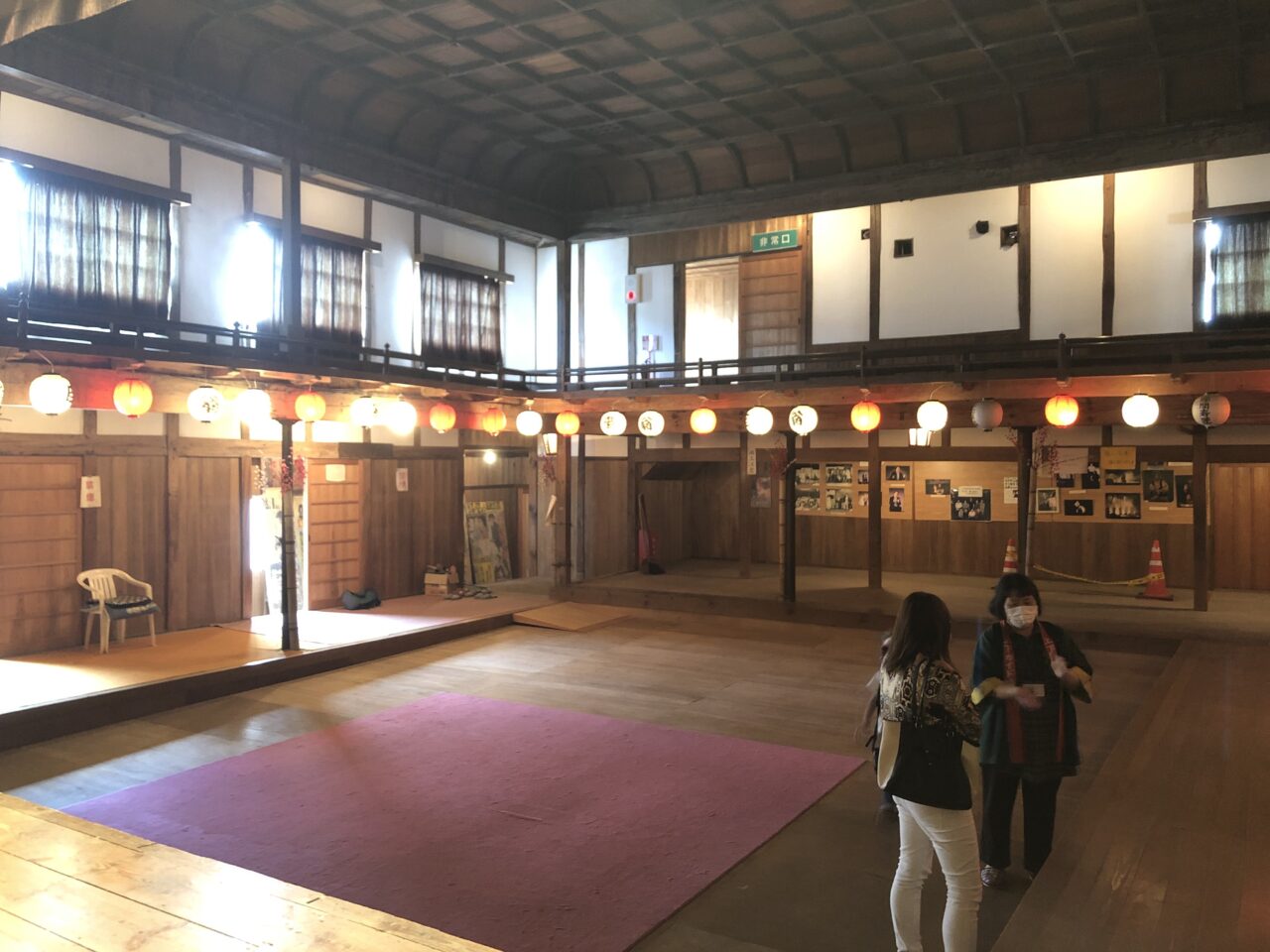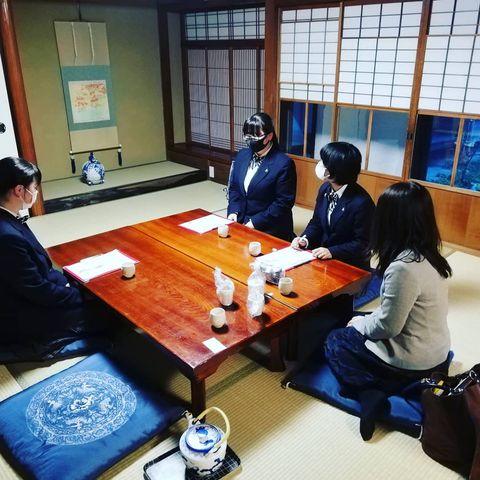Renowned Kabuki Theater, Okinaza
Hello there everyone! This is Mary, back with another entry in my JOGE blog series. Joge is a small town in northern Hiroshima where the charm of traditional Japanese lifestyle, architecture, and hospitality abounds. It is my hope that by writing English content about Joge, many people will come to know and love this town like I do.

Back in October, when a group of local guides took my friend and I around Joge, we briefly visited the famous kabuki theater, Okinaza. Over my three years living in the area, I had been to Okinaza many times, but I wanted to learn more about the historical and cultural significance of this building in Joge and in Japan. My friends Mr. and Mrs. Morimoto, leaders in the town of Joge and in the preservation of Okinaza, kindly agreed to give me a more comprehensive tour so that I could dedicate an entire blog to the playhouse.
During the Meiji period, Joge’s local theater had grown old and difficult to use. This was unfortunate by all standards, but especially since, in those times, there were few entertainment venues in town, and the poor road quality made it difficult to travel elsewhere.

In 1925, Joge’s wealthy barons banded together to fund the construction of Okinaza. The local carpenter charged with leading construction travelled all the way to Kyoto to study techniques at the famous Minamiza Kabuki Theater. When he returned, he manned the ambitious project, which took four years to complete.

Mrs. Morimoto’s mother when she was 13, participating in a kabuki show at Okinaza. She remembers the script of the performance even today!
People began traveling from around Japan to perform and attend performances at Okinaza. There was kabuki, dance, and plays. Professionals and locals alike used the stage to exhibit their prowess or progress in the arts. Okinaza became a hub for both wealthy barons and common folk alike to gather, relax and have a good time.

As the Morimoto’s fondly recounted stories of performances past, it became easy to imagine the atmosphere. Okinaza’s original floor was made of dirt, so families and groups of friends or coworkers sat picnic style on blankets. They either brought their own food and drink, or purchased tea, sake, or sweet dumplings in-house. If a popular performer came to town, the 500-person capacity building would overflow with some 700 people! When patrons were pleased with the performance, they would toss money onto the stage, sometimes wrapping it in Japanese washi paper.

There are some features of Okinaza that make it truly unique among Japanese playhouses. The stage curtain, decorated with a sea bream or tai fish symbolizing celebration, opens from right to left, which is highly unusual.

The bamboo framework above the stage served as a platform for stagehands to drop petals or faux snowflakes over performers, enhancing the scene. As someone with a fear of heights, I mentioned to the Morimoto’s that I would be terrified to go up there, but they assured me that bamboo is quite sturdy.


There is even a manpowered rotating platform to add variety and drama. In this photo, you can see a wooden mechanism in the hole below Mr. Morimoto that a few men would use to physically rotate the stage.

Okinaza also has a second floor, reserved for wealthier patrons, which features a double railing as you can see in these photos. Apparently the theater staff would actually crouch in the space between the railings to dole out drinks and snacks to their customers. Again, due to the real possibility of toppling to the ground floor, I’m not sure I would have had the courage to work at Okinaza back in the day!


The Morimoto’s made sure to point out the impressive, graceful curve of these railings, which weren’t carved but rather pulled into shape using pressure and heat. Like with the rest of the structure, the railings were all handmade, as there were no machines available at the time.

Finally, there is the unique, arched roof, curved on the sides to improve acoustics. There were no microphones or speakers back when Okinaza was built; thanks to this roofing style, more typical of shrines and temples, those sitting far away or on the second floor could hear performances clearly. Crafted using yakusugi from the renowned lumberyards of Kagoshima, this expensive roof was a status symbol, illustrating the affluence of Okinaza’s wealthy funders.

After our tour of the building, I asked the Morimoto’s about Okinaza’s more recent history. During World War II, most of Japan’s playhouses were destroyed in air raids. Professional artists and actors flocked to countryside theaters untouched by the war, including to Okinaza. The facility was also used for cultural festivals, comedy shows, and film showings. There was even a time in Okinaza’s history when the floor was outfitted with movie theater-style chairs for film screenings!
Today, the locals continue to hold occasional events at Okinaza. For example, when groups of foreign tourists come to town, they are invited to Okinaza for kimono photo shoots, kagura shows, or even ninja workshops. My favorite anecdote was when an educator from the UK performed an impromptu performance of Shakespeare’s Sonnet 18 on stage! Local witnesses talk about the occasion with fondness even today. I wonder if the wealthy barons who funded Okinaza could have imagined such a beautiful cross cultural moment occurring in their own theater.
Due to tightening fire safety laws, Okinaza is becoming steadily more difficult to use for these types of events. This wooden building—the last remaining wooden playhouse in the Chugoku region of Japan—is molding and warping. The family that used to tend to the structure’s upkeep has grown too old to continue, so the local people are seeking funding from the government to maintain and update the structure in adherence with modern day earthquake and fire safety guidelines.


Mr. and Mrs. Morimoto guiding myself and foreign tourists through Okinaza
Okinaza is a true treasure – this type of playhouse cannot be recreated by modern construction techniques. The Morimoto’s and many others in Joge care deeply about preserving it for future generations. Mrs. Morimoto’s mother used to perform in kabuki plays at Okinaza and Mr. Morimoto, who volunteers to clean the building, helped to host movie screenings there. In a town with a dwindling population, the locals are determined to share the charm and magic of Okinaza with generations to come. We hope you will come visit, and experience the magic of Okinaza for yourself!
Okinaza Theate
A National Tangible Cultural Property and one of the most renowned wooden playhouses in the Chugoku region. You must be accompanied by a local guide to enter (reservation required).
>>https://jogetenryo.com/meguru/sight/walking/6

Mary Popeo has lived in Hiroshima Prefecture for four years, three of which she spent in Joge. She is passionate about sharing the magic of the Japanese countryside with people from around the world. Mary currently works at a peace education nonprofit in Hiroshima City, and collaborates with Fuchu City and the Joge Town to plan programs for inbound English-sp
《大正時代の木造芝居小屋『翁座』》
皆さん、こんにちは!メアリーです。
上下町は伝統的な日本の生活様式や建築様式、そしておもてなしの魅力にあふれた広島県北部の小さな町。こうして英語で説明することで、海外の皆さんも上下町を知ってくださり、私のように好きになってくださると嬉しいなと思っています。
昨年の8月、友達と一緒に上下ガイド協会の方に町を案内していただいた時、この「翁座」という劇場に立ち寄りました。これまでも何度も翁座には行っていたのですが、この建物が上下や日本にとってどんな歴史的意義や文化的意義を持っているのかもっと学びたいと、改めて上下の町の歴史に詳しく、翁座の維持管理に尽力されている守本夫妻に『翁座』についての説明をして頂きました。
明治時代、上下町にあった劇場は老朽化が進み使えなくなっていました。町には娯楽の場もほとんどなく、道も悪くてどこへ旅をするのも楽な時代ではなかったそうです。
1925年、町内の有力者たちが集まり、翁座を建立するために資金を出し合うことになったそうです。棟梁となった地元の大工さんは、歌舞伎劇場として有名な南座の建築技術を学ぶため、はるばる京都まで行ったんだそうです。
帰郷した彼は完成まで4年を要した大プロジェクトに取り掛かったのです。
守本さんのお母様・・・13歳の時歌舞伎に出演・・・今でも台本を覚えていらっしゃるそうです!
翁座で上演するため全国から人々が来るようになりました。
歌舞伎あり、踊りあり、芝居あり・・・舞台では、プロも地元の人たちも隔てなく芸や練習の成果を発表しました。
翁座は有力者にとっても、一般の人たちにとっても、集い心を解き放って楽しむ場となったのです。
守本さんが上演された当時の出し物のことなどをとても親切に話してくださったので、どんな雰囲気だったのかイメージしやすかったです。
以前の劇場は地面が土のままだったらしく、家族連れや友達らはピクニックのように敷物を敷いて座ったそうです。食べ物や飲み物を持ち込んだり、館内でお茶やお酒、甘いお饅頭などを買って食べたりもしました。
人気芸人が出演すると定員500人のところに700人もの人が集まったのだそう!演技を気に入ったご贔屓さんが、時には小銭や和紙にくるまれたおひねりを舞台に投げ入れたりもしたそうです。
翁座が数ある日本の劇場の中でユニークなものとなったのには、いくつかの特徴があります。おめでたい事のシンボルである“鯛”がほどこされた舞台の引幕は右から左へと開き、とても素晴らしいものです。
ステージの上に竹で組まれた枠はシーンを盛り上げるため、裏方の人が花びらや雪片を降らせるための足場です。
高所恐怖症の私はとても怖くて上がれないと言うと、竹はとても頑丈なので大丈夫だよと守本さんはおっしゃいました。
上演中、変化を付ける効果を出すために人力で回転させる舞台もあります。
こちらの写真では守本さんの照らす穴の中に数人の男性で舞台を回したという木製の装置が見えますよ。
写真でもお分かりのように、翁座の二階には二重にほどこされた手すりが特徴で、これはお金持ちのご贔屓さん専用の指定席でした。売り子さんがこの手すりの間を体を低くして飲み物やおつまみ運んでいたそうです。
私にそんな時代に遡って翁座で働く度胸があるかなぁ・・・下の階に落ちてしまうかもしれないのに!
守本さんから、この優美な手すりの曲線は最初から曲がっていたわけではなく、型にはめて圧や熱を加えて曲げたものだということを教えてもらいました。建物のほかの箇所と同じように、当時は便利な機械があるわけでもなく、手すりもすべて手作りだったんですね。
最後は音響効果を高めるために端が湾曲している珍しいアーチ状の天井です。
翁座が出来た頃はマイクもスピーカーもありませんでしたから、神社仏閣特有のこのスタイルの天井にしたおかげで、舞台から離れた席や二階席に座ってる観客も上演中の音をはっきりと聴くことができたのです。
鹿児島に自生する有名な屋久杉を使って精巧に作られていて、この高価な天井は翁座建立の出資者たちの富の象徴でもあったのですね。
建物の説明をうかがった後、守本夫妻に近年の歴史について質問してみました。
第二次世界大戦中、国内のほとんどの劇場が空爆に遭い壊れてしまったそうです。芸術や俳優を本業とする人たちは戦火を逃れ、翁座のような田舎の劇場に集まって来ました。また近年これらの劇場だった施設は文化祭やコメディショー・映画上映などにも使われたそうで、翁座も一時は映画上映のために映画館様式の椅子が設置されたそうですよ。
現在、地元の人たちは折にふれて翁座でイベントをしています。例えば外国人観光客が来町した際には着物を羽織って写真撮影をしたり、神楽を観たり、時には忍者体験をしたりしています。
以前、ツアーで参加されたイギリス人男性が舞台で即興で『ウィリアム・シェイクスピア ソネット18』を披露したという逸話も私のお気に入りです!
今でも上下のみなさんはそんな出来事を嬉しそうに話します。翁座へ出資した人たちは自分たちの建てたこの劇場でそんな素敵な文化交流が起こることを想像できたでしょうか?
消防法が厳しくなり、翁座もこのようなイベントに使うことがだんだん難しくなってきました。この木造の建築物・・・中国地方にただひとつ現存する木造の劇場は朽ちたり傾いたりし始めています。この建物を維持しようと頑張ってこられた所有者の方もお年を召し、維持が難しくなりました。そこで町の人は建物の維持と近年の耐震や防火基準に適した最新化のための公的資金を求めています。
私と外国人旅行者に翁座の説明中の守本ご夫妻
翁座は本当に貴重な財産です・・・現代の建築技術では再建できない劇場です。
守本さん、そして多くの上下町の方々が次世代まで遺したいと懸命になっていらっしゃいます。守本さんの奥様のお母様は翁座で歌舞伎に出演されていましたし、ボランティアで掃除をされているご主人は映画の上映を主催されました。人口減少が加速しつつある上下町の人たちは、町を訪れる人たちと一緒にこの翁座の魅力を共有したいと思っています。皆様もぜひ上下にいらして翁座のすばらしさをご自分で感じてみてください!
「翁座」
国の登録有形文化財かつ中国地方有数の木造建築の劇場のひとつ。
街並みガイドさんが同行します(要ご予約)。
https://jogetenryo.com/meguru/sight/walking/6
メアリー・ポペオ
広島県在住歴4年、そのうちの3年間を上下町で過ごす。来日した海外の人たちと広島県の田舎の魅力を共有することが願い。現在は広島市内で非営利の平和教育団体で働いており、府中市や上下町とも協力しながら英語圏からの旅行者の受け入れなどの企画をしています。







